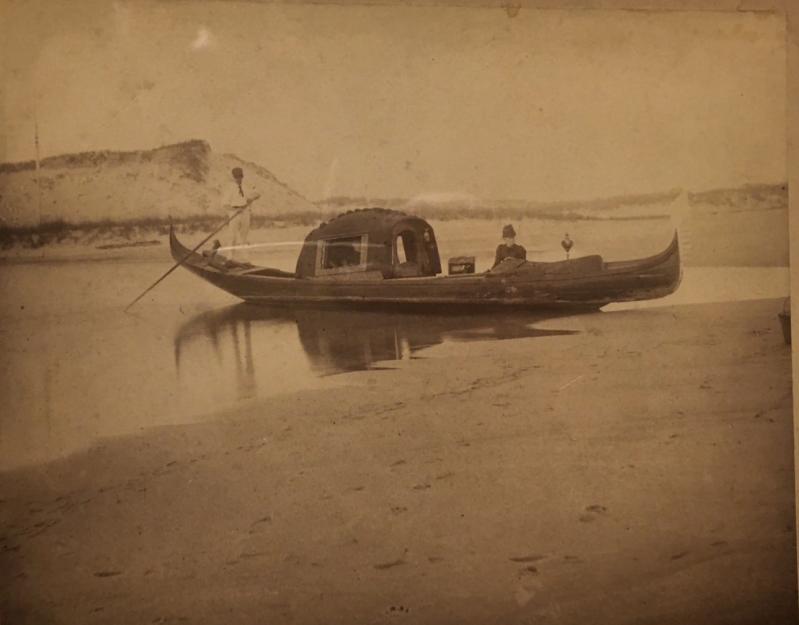An obscure 75-year-old snippet from the May 22 "Way It Was" column in this paper told of a 36-foot gondola being transported by Pennsylvania Railroad car to the Mariners' Museum in Newport News, Va.
This really hit home for me.
During my elementary school years, I would ride my bike to and from school and early-morning altar boy service at St. Philomena's, now Most Holy Trinity. At dawn in the spring and summer there was an indescribable scent in the air as the dew-wet grass, plants, and shrubs along Town Pond released their overnight perfume.
Rapidly riding down the small hill outside my home on Ocean Avenue and then crossing an always-empty Woods Lane, I would shoot up onto the elevated sidewalk from the Lambs' Moran Studio, past Condie and Boots Lamb's real estate office and the Maidstone Arms next door, and turn the corner up a steep Mill Hill Lane. It was on this short passage that this indescribable dawn-dew scent was especially pungent.
This little stretch has always been of great fascination to me. Town Pond, with its stately chestnuts, was a tried-and-true fishing hole as well as a skating rink to young boys and girls alike. Mill Hill was one of the few sledding hills in the area, and Lion Gardner's tomb in the cemetery opposite Mill Hill evoked medieval visions in a small boy's active mind.
My mother and father first met at the Maidstone Arms — a popular watering hole in the days following World War II. Growing up, I never quite figured out the name "Boots," but I've forever been intrigued. And then there were the Morans.
My dad, Robert Gordon Reutershan, who was on the board of Guild Hall, was a lover of art, music, and theater. I have spent most of my life in daily contact with paintings and etchings from both my father's collection and mine, many produced by Thomas, Mary Nimmo, Edward, and Percy Moran, and several others of their circle. Since I was 6 or 7 years old, I, too, have had a lifelong love for art and artists, and the Morans have always held a prominent place in this avocation.
It was the crystalline quality of the air and the old farms and buildings that originally drew both the Morans and members of the Tile Club to East Hampton in the late 19th century. Over the ensuing 150 years the explosion of American art produced in our little town continues to echo through the halls of the world's greatest museums. From Moran to Hassam, from Pollock to Motherwell and de Kooning, East Hampton has been a storied source of inspiration and masterworks.
In the late 1980s I had recently moved from London to an 1877 townhouse on Logan Circle in Washington, D.C. One afternoon while leafing through a Swann Galleries auction catalog, I was drawn to a short headline, "Robert Browning's Gondola." The item, dated July 3, 1909, was a handwritten six-page letter from Thomas Moran to his art dealer, a Mr. Ricketts of Moulton & Ricketts in Chicago, following up on a recent visit Ricketts had made to East Hampton.
The entire letter described his purchase of Robert Browning's gondola during a visit to Venice. It was accompanied by two original albumen cabinet card photos mounted on board and three additional silver prints.
To a lover of East Hampton and its art and artists, this had it all. The albumen photos were of Thomas Moran and his wife, Mary Nimmo Moran, out for a boat ride and a picnic lunch on the Atlantic side of Hook Pond, propelled by a Montaukett, George Fowler. The silver prints were of the gondola and its parts, laid out in front of the eclectic old Moran house that I passed twice daily on my bike rides to and from school and church.
In 2011, I was delighted that my then-hometown museum, the National Gallery of Art, featured an exhibition, "Venice: Canaletto and His Rivals." Prominent in it was Moran's Robert Browning gondola and several mates of my albumen photos.
"The arrival of the gondola at Hook Pond, East Hampton, drew local attention and was written about in the East Hampton Star on September 13, 1890," a note in the exhibition stated. "The paper described a small party who 'enjoyed a sail around the pond on that novel craft' steered by George Fowler. Moran had hired Fowler, a Montauk Indian, in the belief that he could apply his knowledge of the canoe to the similarly shaped gondola."
Moran wrote that he had purchased the gondola in Venice earlier in 1890 "while on one of my visits there with Mrs. Moran. It was so beautiful & fine in its carvings, brasses & fittings that we fell in love with it. . . ." As to its provenance, "After all the preparations were completed & the boat packed for shipment the manager of the Grand Hotel, where we were staying, announced to me one day, 'Perhaps Mr. Moran it will add to your interest & pleasure in your gondola to know it belonged to Robert Browning, the poet. He presented it to the old gondolier from whom you bought it when he was leaving for one of his stays in England.' "
With all of the publicity over the past decade celebrating the restoration of the Moran Studio, here is a different perspective on "The Way It Was."
Chris Reutershan lives in Bel Air, Md.

